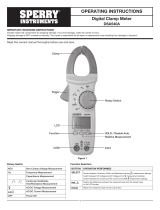
13
7.9. Continuity Measurements
1. lnsert the black test lead into the negative COM terminal and the red
test lead into the V CAP TEMP Hz%
Ω positive terminal.
2. Set the function switch to the
Ω position.
3. Use the MODE button to select continuity " ". The display icons will
change when the MODE button is pressed.
4. Touch the test probe tips across the circuit or component under test.
5. lf the resistance is < 50Ω, a tone will sound.
7.10. Non-Contact AC Voltage Measurements
WARNING: Risk of Electrocution. Before use, always test the Voltage
Detector on a known live circuit to verify proper operation
1. Touch the probe tip to the live conductor or insert into the live side of
the electrical outlet.
2. lf AC voltage is present, the detector light will illuminate.
NOTE: The conductors in electrical cord sets are often twisted. For best
results, rub the probe tip along a length of the cord to assure placing
the tip in close proximity to the live conductor.
NOTE: The detector is designed with high sensitivity. Static electricity or
other sources of energy may randomly trip the sensor. This is normal
operation.
7.11. MODE/VFD (Variable Frequency Drive)
1. Press MODE/ VFD key to select the double measurement functions.
This key is active in V CAP
Ω position to select among resistance
test, diode test, continuity test, HZ%, and in Temp position to select
between °F or °C.
2. Press and hold the MODE/VFD key and turn the selector switch to turn
the system on, the auto power off function will be cancelled.
3. Press and hold the MODE/VFD key for 2 seconds to switch to VFD.
7.12. HOLD/Flashlight
1. To freeze the LCD reading, press the Hold/Flashlight button. While
data hold is active,the HOLD icon appears on the LCD. Press the
button again to return to normal operation.
2. The LCD is equipped with backlighting for easier viewing, especially in
dimly lit areas.
3. Press the Hold/Flashlight button to turn the Flashlight on. Press again
to turn the Flashlight off.




















